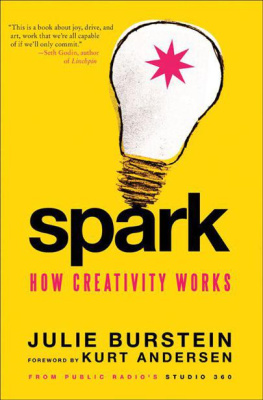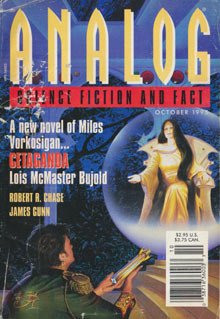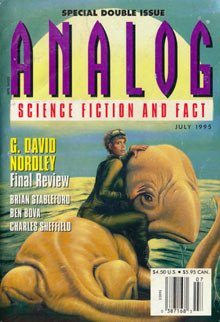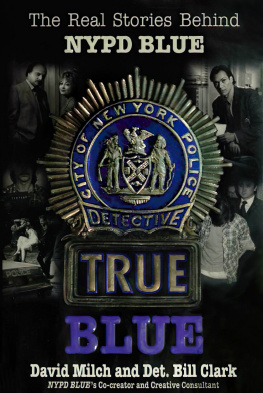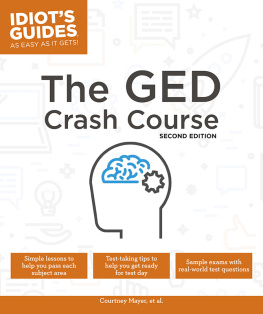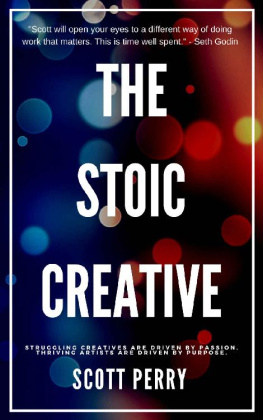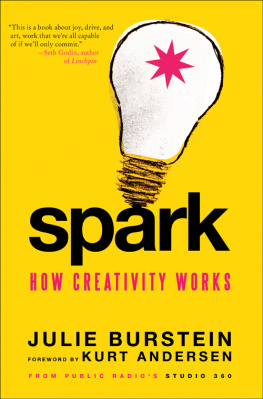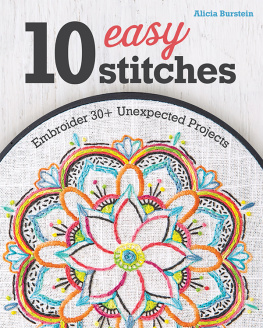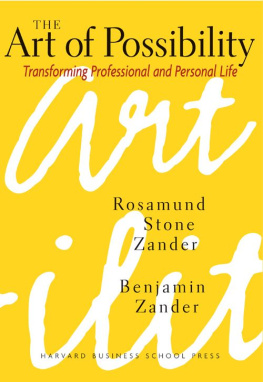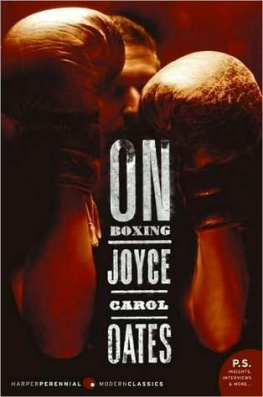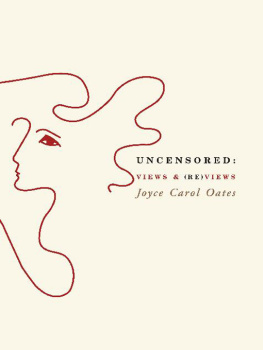SPARK
How Creativity Works
Julie Burstein
Foreword by Kurt Andersen

Dedication
For my mother, Janet Handler Burstein
Contents
by Kurt Andersen
August 6, 2010
I graduated from college with no job in the offing and no desire to return home to Nebraska. All I knew for sure was that I wanted to live in New York City, hang out with people doing creative work, and get paid for doing creative work myself, but that I didnt know how to act or sing or dance or play an instrument or draw. When I was twenty-one, that was the extent of my career plan. And oddly enough, Ive executed it in all its half-assed, unkempt glory for the last thirty-five years: Im a New Yorker; my friends are mostly writers and artists and filmmakers and musicians and designers, and Ive earned my living in pretty much every creative field that doesnt require me to make music or draw. Or dance.
But it was just a decade ago that I had two back-to-back aha moments that finally explained my zigzagging professional path to myself and also made me understand the prerequisites for creativity.
The first lightbulb went off when I read an essay called The Amateur Spirit by the great scholar and writer Daniel Boorstin. The main obstacle to progress is not ignorance, Boorstin wrote, but pretensions to knowledge.... The amateur is not afraid to do something for the first time.... the rewards and refreshments of thought and the arts come from the courage to try something, all sorts of things, for the first time.... An enamored amateur need not be a genius to stay out of the ruts he has never been trained in.
Here was a supremely credentialed prince of the Establishment, the ultimate professional intellectualRhodes Scholar, Ph.D., professor at the University of Chicago and Cambridge University, museum director, Librarian of Congressarguing in his seventies that while professionalism of the good kind (knowledge, competence, reliability) has its place, it is the curious, excited, slightly reckless passion of the amateur that we need to nurture in our professional lives, especially if we aspire to creativity in the work we do.
A few months later I found myself interviewing my funny, brilliant friend Tibor Kalman, the graphic designer and multifarious auteur. A transcript of our conversation would appear in a monograph about his work. He was forty-nine and when we talked he knew he had only months to live. Tibor had always been smart about the nature of creative work, but now the wisdom was pouring out.
You dont want to do too many projects of a similar type, he told me. I did two of a number of things. The first one, you fuck it up in an interesting way. The second one, you get it right. And then youre out of there. I have sought to move into as many other fields as possible, anything that could be a step away from graphic design, just to keep from getting bored. As long as I dont completely know how to do something, I can do it well. And as soon as I have [completely] learned how to do something, I will do it less well, because what I do will become more obvious.
I realized my entire professional and creative life so far had been conducted in a similar way, by indulging the amateur spirit: Id repeatedly, presumptuously barged into jobs for which I had no credentials or much specific training and then worked extra hard, hoping that my rank inexperience might somehow be transmuted into interesting innovation. Id had no experience writing radio and TV news scripts (for NBC, my first job), or about politics or crime (for Time , my second job), or about architecture and design (also for Time ), and when I cofounded Spy magazine (my fourth job), I had never edited anyones writing but my own, or run a business. Ditto when I wrote and produced prime-time network comedy specials (for NBC), wrote an off-Broadway revue, wrote a screenplay (for Disney), and sold my first novel (to Random House). Professor Boorstin and my friend Tibor had convinced me retroactively that what Id done by accident, going from interesting gig to interesting gig with no real strategy, had a philosophical basis.
Shortly after that double epiphany, executives from Public Radio International and WNYC called me out of the blue and asked if I might be interested in hosting a new program they wanted to create about the arts and entertainment and creativity. Really? Me? My total on-air experience consisted of having been interviewed a few times about books and articles Id written. Host a weekly show on public radio? Were they serious? Id done plenty of things I had no standing to do, but no one before had ever invited me to do something I had no standing to do.
Thats not completely true. Twenty years earlier, a theater director had called me out of the blue and asked if I might be interested in playing the lead in his upcoming production of Othello . Really? Me? My total acting experience consisted of playing Captain Hook in a grade school production of Peter Pan. And also, I am, um, er, Caucasian. Was he serious? Well, as it turned out, um, er, uh, no : hed meant to call an (African American) actor named Curt Anderson. Wrong number.
But this time, it turned out, the public radio grown-ups really had intended to call me, and not the veteran radio personalities Curtis Andreessen or Karl Andrews or Carter Andrazs. They were serious. And thats how I came to help invent and host Studio 360 .
What we do every week on Studio 360 is try to show how creativity works by means of individual case studies, by talking at length and in depth to some of the worlds most talented people about how and why they do what they do. And for this book weve distilled the most relevant wisdom from my hundreds of conversations to create a kind of plain-English master class about the difficult, exhilarating process of pursuing ones creative passions. Its Creativity 101 featuring guest lectures by visual artists and designers Chuck Close, Denise Scott Brown, and Robert Venturi; filmmakers Kathryn Bigelow, Ang Lee, Mira Nair, and Kevin Bacon; writers Richard Ford, Joyce Carol Oates, John Irving, and Tony Kushner; musicians Patti LuPone, Rosanne Cash, Robert Plant, Yo-Yo Ma; and many other artests. Maybe youre an artist or would-be artist yourself; maybe youre an amateur singer or painter or writer. If so, consider this a collegial primer on how some supremely talented and successful people unleashed their talents and achieved their successes. But Im also convinced that there are plenty of valuable, hard-won lessons about living and working creatively that can be applied to almost any life and any job. Or maybe you simply want to enjoy an unbuttoned, intimate look at the life and times of a few dozen cultural superstars. If so, enjoy.
What Ive realized after talking to this remarkable pantheon of creative people for our five hundred shows is that what I learned from Daniel Boorstin and Tibor Kalman a decade ago is true of pretty much all work worth doing, especially creative work: the prerequisite for doing exciting work is to be excited about it yourself, reaching to do or make something that you havent done or made before and which seems at least a little scary, just beyond your comfort zone. E. B. White famously wrote that no one should come to New York to live unless he is willing to be lucky. The same goes for people who want to do any kind of creative work.
As soon as I adopted this paradigm of the amateur spirit just over a decade ago, taking risks to try new things, staying out of ruts, refusing to be paralyzed by the fear of imperfection or even failure, opening myself to luckthat is, once it became my conscious MO rather than simply the way Id unthinkingly stumbled through lifeI began spotting other members of the club, such as Danny Boyle, the director who made 127 Hours , Slumdog Millionaire , Trainspotting , and eight other feature films. Everything after the first one, he told the New York Times , is business. Theres something about that innocence and joy when you dont quite know what youre doing. And Steve Jobs, talking about the unexpected upside of being purged from Apple nine years after he founded the company. The heaviness of being successful, he says, was replaced by the lightness of being a beginner again, less sure about everything. It freed me to enter one of the most creative periods of my life. A period during which, among other things, he founded the amazing animation studio Pixar.
Next page
